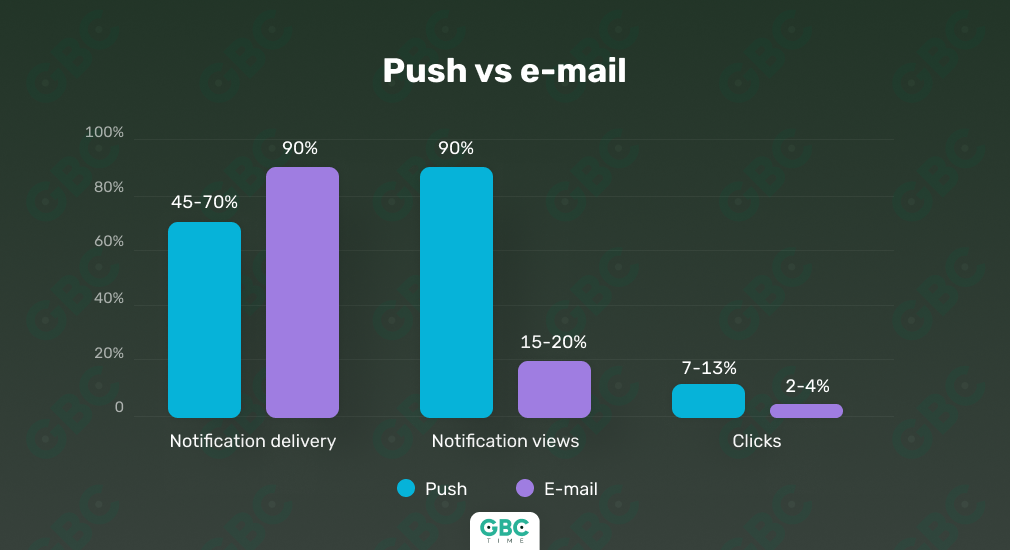Companies in all areas of business use push traffic, which is gradually replacing email newsletters, to remind about themselves. How useful modern push systems can be when it comes to managing this traffic, analyzing and forecasting it, read in the GBC Time article.
Every day, 3.8 billion smartphone users worldwide install and use applications. Every fifth owner of a smartphone between the ages of 25 and 40 opens applications on the screen more than 50 times a day, which means that people literally don’t take their smartphones off their hands.
With the help of smartphones, they make purchases, follow loyalty programs, spend time in line at the doctor, read books, watch movies, communicate with friends, and, of course, play games. But what depends on whether the user returns to the application or leaves it gathering dust on the fifth page of the screen, which no one scrolls through? No, not only because of how high-quality, convenient, and interesting the app is made but also because of how effectively it can remind of itself. You can send email letters to the user, but, as statistics show, this is not the best choice.

Despite the high percentage of delivery, the effectiveness of letters remains low. To get one click, you need to send a push message to five users, and an e-mail to 15. Thus, for equal effectiveness, you need a 3-4 times larger contact base.
Push services are already used by 80% of affiliates
With push notifications already got popular and even keep gaining momentum, it would be unwise to ignore this type of user interaction. Wild Wild Leads’ buyer and retention management teams tested several products to find the best tool in the market, but something was always missing. Therefore, the company decided to create its own.
“Retention is a full-fledged marketing tool that remains underestimated by both advertisers in the gambling market and affiliates, so our main requirement is described as – the system should not only deliver the message, but also do it as efficiently as possible, to the right leads, at the right time and give an understanding of which push in which country and at what time led to registration and deposit, which simply led to a large number of clicks, and which led to the deletion of the application. And choose the best one,” says Oleksandr Vovkulak, Team Lead of IT/R&D Wild Wild Leads.
In affiliate, the retention and return of leads to the offer is up to 30% of the income
Buyers evaluate the prospects of the offer in view of the location and the target audience. Now there is an opportunity to control which pushes and which offers are set up, to adapt them to the target audience and the offer.
Automatic translation of text messages into the language of the user’s device has become an indisputable advantage in the multilingual world. This technology saves time and helps to reach multiple language segments of the audience.
Thanks to the user behavior tracking feature, after each push notification is sent, the buyer finds out the reasons affecting the conversion: too frequent sending or, on the contrary, too rare, irrelevant CTA in the text or illustration, incorrect order of pushes, or time of sending. This is how the factors of weak conversion are revealed, influencing which it is possible to take away the drop in traffic or significantly improve it, and therefore, increase the profit.
During the development of the interface and usability of the Wild Wild Leads tool, the opinion of buyers, marketers, retention managers, and technical specialists was taken into account.
The clear minimalistic interface is complemented by pleasant little things. For example, when creating an offer, you can immediately add them to the desired audience, and select several audiences for one push notification.

Convenient setup and customization allow you to choose the days and local time of departure, taking into account the time zone, and collect information and preferences of users. You can segment the audience internally by several indicators: the number of days after a certain action or the presence of registration and a deposit.
“One of the features is split-testing of pushes. It is no longer necessary to work “blindly”, now the retention team reads reactions and puts forward hypotheses – which appeals work when users respond better,” shares the experience of working with the new push system, retention manager Hanna.
The “Metrics” section shows the dynamics of conversion traffic in a dashboard format.
Pushes are also sent according to the completed event: after the exact time after the user registration and the exact time after the deposit. It is also planned to add an auto-push option (push after a specified period of time after registration or deposit) after installation and additional segmentation based on neural networks and prediction of the probability of the first or second deposit.
“The set of tools resulted in a 30% increase in conversion of fresh traffic, a 60% increase in retention traffic older than two days, and more flexible sending and changing push scenarios,” says Hanna.
How to access Wild Wild Push
The Wild Wild Push service for testing the demo is available for free to WWApps customers until the end of summer, the team is working on the compatibility of the system not only with its own but also with third-party products. This function is planned to be implemented by September 1.
To get access to the tool, you should write to your manager.
If you have not yet cooperated with the company, then it is very easy to get started: you need to text via Telegram, get access to the bot and deep link, and start driving traffic to any geo.












